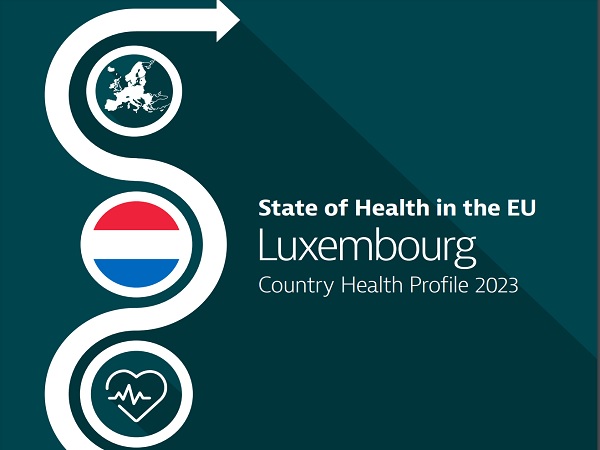 State of Health in the EU - Luxembourg - Country Health Profile 2023;
Credit: European Commission
State of Health in the EU - Luxembourg - Country Health Profile 2023;
Credit: European Commission
Luxembourg's Ministry of Health and Social Security and the Representation of the European Commission in Luxembourg have announced the publication by the European Commission of the latest "Country Health Profile" for Luxembourg.
Country health profiles are produced by the Organization for Economic Co-operation and Development (OECD), the European Observatory on Health Systems and Policies and the European Commission. These publications provide an overview of health and healthcare systems in all EU Member States as well as Iceland and Norway, highlighting the particular characteristics and challenges of each country.
The results of the "Country Health Profile 2023" for Luxembourg concern the year 2021 or, failing that, the latest year available. The National Health Observatory, the Health Directorate and the General Inspectorate of Social Security contributed to the preparation of the report for the indicators and comments concerning Luxembourg.
Key findings
Life expectancy at birth in Luxembourg reached 83 years in 2022, i.e. 2.3 times higher than the EU average. It rebounded from a temporary decline in 2020.
Concerning health status and risk factors linked to health behaviours, Luxembourg residents recorded more years of healthy living than the EU average. In 2020, women aged 65 could expect to live another 21.8 years, including 11.3 years without limitation in daily activities or a disability, while men could expect to live 18.5 more years, including 10.4 years in good health.
On the other hand, around 45% of Luxembourg residents aged 65 and over reported living with more than one chronic illness, which was significantly higher than the EU average, especially for men (44% in Luxembourg compared to 32% for the EU average).
The leading causes of death in 2020 were circulatory diseases such as stroke and ischemic heart disease, tumours and COVID-19. In 2021, tumours became the leading cause of death, with mortality attributed to cancers decreasing less rapidly than that attributed to cardiovascular diseases.
Moreover, more than one-third of deaths occurring in Luxembourg in 2019 could be attributed to behavioural risk factors, including smoking (17% of deaths), dietary habits such as low consumption of fruit and vegetables and high consumption of sugar and salt (13%), alcohol consumption (7%), physical inactivity (2%) and exposure to air pollution and ozone (2%).
Concerning the health system and the evaluation of its performance, in terms of accessibility, the share of public health spending in 2021 was the second highest in the EU, representing 86% of the total (compared to 81% on average in the EU), a share which has continued to increase since 2012 (83%). Expenditures borne by households represented only 9% (among the lowest in the EU).
Moreover, unmet needs for medical and dental care were among the lowest in Europe in 2022. Concerning medical care, only 0.5% of the population reporteded unmet needs due to costs, the distance to travel or waiting times, compared to 2.2% on average in the EU. For dental care, only 0.8% of Luxembourg residents declared unmet needs compared to 3.4% on average in the EU. That being said, the report found that waiting times for medical care remained a cause for concern in Luxembourg.
In terms of effectiveness, Luxembourg continued to display a low rate of preventable mortality with 134 deaths per 100,000 inhabitants, compared to a European average of 180 deaths per 100,000 inhabitants in 2020. Cancer remained the leading cause of premature death.
The report found there was room for improvement regarding participation in organised screenings. The participation rate for breast cancer screenings has been dropping in Luxembourg, e.g. from 54% in 2019 to 45% in 2021 (well below the EU average). The participation rate for colorectal cancer screening (49% of individuals in the target population) was just above the EU average (47%). In 2020, these screenings suffered interruptions linked to the COVID-19 pandemic.
In terms of health system resilience, the report notes a reduction in certain health services during the COVID-19 pandemic, such as screening programmes, medical consultations and elective surgical procedures. It further highlighted the sustained growth in public health spending beyond the COVID-19 pandemic.
The report also focuses on mental health. In 2019, mental illness affected one in six people, which corresponds to the EU average. The most common mental illnesses were anxiety disorders (estimated 6% of the population), depressive disorders, and alcohol and drug use disorders (4% each).
In 2019, 10% of Luxembourg residents reported suffering from chronic depression compared to 7% on average in the EU. There were also inequalities between gender and income groups. About 19% of women in the lowest income quintile reported chronic depression in 2019, nearly four times the rate of women in the highest quintile (5%). Among self-reported depressed men, 15% were in the lowest income quintile compared to 5% in the highest quintile.
The authorities noted that several actions have been taken by the government in this area, such as first aid training in mental health since 2020, coverage by health and maternity insurance for psychotherapy since February 2023 and the approval of the first National Mental Health Plan in July 2023.
The full report is available (in English) here.








